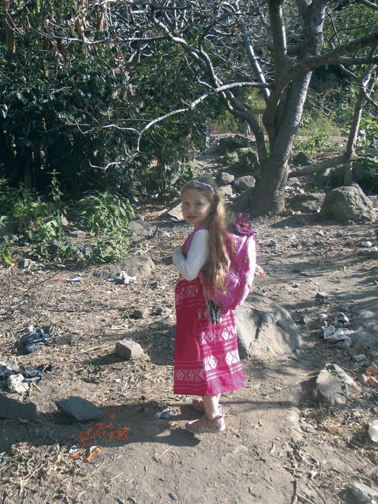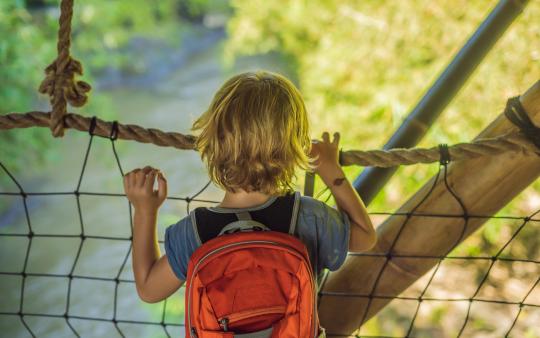Like most middle-class parents in Canada, I parent with a lot more: I obsess about their educational experiences, rush off to the doctor at the first sign of a rash, and worry about which summer camp will be the most enriching.
I know that my parenting worries are a luxury. I also know that there is a very real risk to the kind of parenting I do. My children are more likely to grow up self-absorbed or, worse, have so few real problems that they create their own very real problems: addictions, violence, extreme prejudices.
So, I did what any “rational” person would do: I took my children—ages 5 and 1½—to the developing world. I had a few main goals in going: I wanted my children to learn to appreciate how fortunate we are to live in North America. I wanted them to understand that this is not the way that most people live: easy access to clean water, to consistent electricity, to healthy food. I also wanted them to really learn another language.
Destination: Guatemala
I chose a little town called San Marcos La Laguna in southwestern Guatemala for three reasons:
1. I had friends going at the same time who spoke Spanish so I wasn’t overly intimidated about my lack of fluency in that language. (No hablo Espanol!)
2. It is sunny and warm and dry there when Canada is at its most brutal.
3. Most importantly, they have an unusually diverse and trilingual Waldorf school (Escuela Caracol) with a mix of local Mayans and a strong international community.
So, plans were made. We traveled with three other families all coming from other parts of the world. For all four of us, it was a relatively spur-of-the-moment decision. (For me, three months of planning is spontaneous.)
The reality show
It was an experiment. Was it a success?
When my eldest daughter got Chickenpox, the electricity went out for a week just when I needed to send work to my agent, and when my husband finally arrived after 2.5 months gone and my baby burst into tears and wouldn’t let him out of her sight again (not even to use the restroom), it wasn’t clear.
I had to boil water just to do dishes, hand wash dirty diapers in a sink outside, share my house with scorpions, spiders, and giant ants and share my yard with tiny biting flies, chickens, and the wandering dogs. My friends back home talked to each other with comments like: “Is she crazy?” and “What is she doing to those kids?”
Overall, I was and am more optimistic.

Finding our path
It was my daughter who first found the path to the school: a rocky little trail at a crossroads with a gravel “road” going one direction and a line of coffee-bean sellers going another. The rocky little trail cut straight up the valley and after a 200-metre scramble up, a little hobbit door appeared on the left of the path. With my five-year-old in hand and my baby on my back, we entered into a garden oasis with trees and flowers and chickens and little pathways running between it all. Strikingly, there wasn’t a single Cheetos wrapper, plastic bag, or bottle anywhere here, though these imports pave the rest of the town.
At that moment, I knew it was going to be okay. My daughter’s classroom was a thatched roof, wooden gazebo-like structure. Each component thoughtfully carved by hand: cubbies to hold little shoes and backpacks, a cradle and silk tent for the cotton and wool doll baby, and four little tables with matching benches. Everything carved, hand knit, or plucked from nature.
There were 24 kids in my daughter’s class: more than half were local Mayans and the rest were expats from all reaches of Europe, North America, and Central America. The average child spoke three languages. There were two teachers: Vanessa who was from the U.S. and was raised bilingual, Spanish and English, and the assistant who spoke Kaqchikel and Spanish. They were calm, encouraging, and smart in that way that Waldorf teachers usually are.
My daughter loved the school, the other children, and mostly her teachers. Even though her assistant teacher did not speak English, my daughter loved her all the same. It was as if this Maestra, by not getting overly caught up in my five-years-old’s explanations, could see right through to the underlying situation or need. Her calm, encouraging presence was enough to stop tears, calm fights, and guide play.
I learned that children best learn language through play. Maestra Vanessa said she had witnessed this phenomenon while running a Spanish immersion program in the Bay Area. It continued to be true in this extremely multilingual classroom: the kids who played in Spanish, learned Spanish. Those, like my daughter, who stayed in smaller groups seeking out the few other kids who wanted to just play in English (or Kaqchikel), didn’t advance as deeply or completely into Spanish. The kids who found a Spanish-speaking best friend or were more interested in large group play, quickly learned Spanish because they had to.
Adios
In Spanish, Adios is used to mean “goodbye,” but literally it translates into roughly “go with God.” It was after returning home that I really began to see how much of an impact our time in Guatemala did have on us. My eldest walked around for weeks, exclaiming: “We can drink water from ANY tap! It’s amazing!” Or gathering up pennies from her penny bank to give away, because: “We are rich!” There were other amazing moments. Like the ones before we left Guatemala, where she burst into tears at her pale hair and skin because she didn’t look like a “real Mayan” or where she gave the shoes off her feet to one of her classmates. (The kids there hike in cheap flip-flops and few own anything that we would consider a real shoe.)
It is possibly my friends, Leif and Cilla Utne, who inspired the trip that sum it up best, though. Even more than I, they had compelling reasons to uproot their lives: their son was adopted from Guatemala. This, combined with a commitment to Waldorf, a love of San Marcos from previous visits, and jobs that allowed them to work from anywhere meant the trip seemed almost inevitable for them.
Leif says, “We were hoping to expose him [our son] to an alternative to the wealthy, suburban experience. Not sure how deeply it sunk in, but I also think it is a long term process. I think on some level he was conscious of that in Guatemala. The kids’ homes we visited lived in bamboo and mud shacks with open fires indoors and chickens tied up in their front yard. They had no toys. The reality of daily life for those kids is very, very different from his reality here, but I am not sure how much of it stuck or how consciously he was able to analyze that.”
He chuckles and sighs and then recounts a story from earlier that day where their son, almost 6, threw a fit at a store over a toy he wanted and wasn’t given. These were the kinds of things that the Mayan children in Guatemala did not do, and what we both had sort of imagined our children would not do either after their experience.
He continues, “Our hope is to be able to keep going back and exposing him to that different reality as often as we can as he is growing up so he can be conscious of it and learn to at least be more compassionate and emphatic around those differences."
In the meantime, nuestros hijos son los niños de América del Norte, and we wait.









